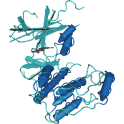
- Remove this product from my favorite's list.
- Add this product to my list of favorites.
Products
Newsletter
 |  |  |  |  |  |

Background: The NIMA-related kinases or NEKs represents a group of protein kinases whose members have key roles in mitosis. Human cells express eleven genes that encode NEK1 to NEK11 sharing approximately 40–45% identity with NIMA kinase, the founding member of this family of Aspergillus nidulan. NEK6 and NEK7 share 87% amino acid identity within the kinase domain and only significantly differ from one another within a short N-terminal extension. NEK6 is activated during mitosis, concomitant with an increase in NEK6 protein level whereas the protein level NEK7 appears to be relatively constant throughout the cell cycle. NEK6 and NEK7 are phosphorylated and activated by NEK9, contributing to mitosis progression.
Human NEK6 ( NIMA "never in mitosis gene a"-related kinase 6), a serine threonine kinase, recombinant and active enzyme, N-terminally fused to GST-HIS6-Thrombin cleavage site
Theoretical MW : 68.041 kDa (fusion proteins)
Expression system: Baculovirus infected Sf9 cells
Purification: One-step affinity purification using GSH-agarose
Storage buffer: 50 mM Tris-HCl, pH 8.0; 100 mM NaCl, 5 mM DTT, 15 mM reduced glutathione, 20% glycerol
Protein concentration: 0.129 mg/ml (Bradford method using BSA as standard protein)
Method for determination of Km value & specific activity: Filter binding assay MAFC membrane
Specific activity : 8,000 pmol/mg min
Entrez Gene ID: 10783
UniProtKB: Q9HC98
Ordering information: shipped on dry ice
O'regan L1, Blot J, Fry AM. (2007) "Mitotic regulation by NIMA-related kinases."Cell Div. 2007 Aug 29;2:25.
Fry AM, O'Regan L, Sabir SR, Bayliss R. (2012) "Cell cycle regulation by the NEK family of protein kinases."J Cell Sci. 125(Pt 19):4423-33.
de Souza EE, Meirelles GV, Godoy BB, Perez AM, Smetana JH, Doxsey SJ, McComb ME, Costello CE, Whelan SA, Kobarg J.(2014) “Characterization of the Human NEK7 Interactome Suggests Catalytic and Regulatory Properties Distinct from Those of NEK6.” J Proteome Res. 2014 Aug 13.
Welcome Login
Contact us
Follow us